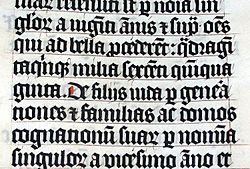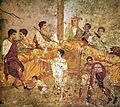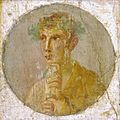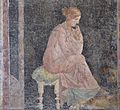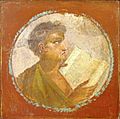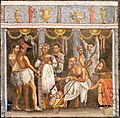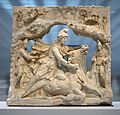Culture of ancient Rome facts for kids
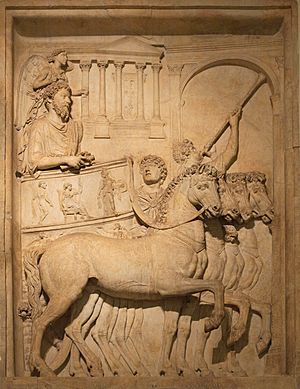
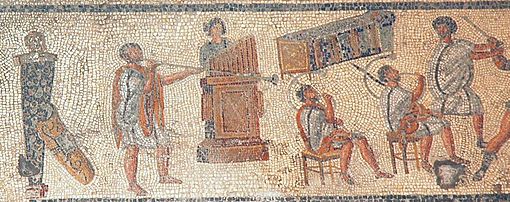
Ancient Roman culture developed over nearly 1200 years. The Romans conquered many lands. They brought back ideas and traditions from each place. Their way of life was a mix of many cultures, ideas, and religions. From the 2nd century BC, Greek influence became very important. Roman architecture, painting, sculpture, laws, and literature became highly developed. Rome was a trading nation. It controlled many different groups of people, mostly around the Mediterranean.
Contents
Roman Society
There were four main groups of people in Rome. These were the rich aristocrats, the equestrians, the common citizens, and the slaves.
Aristocrats
The aristocrat group had about 300 families. Most of them were senators. This group was very powerful.
Equestrians
The equestrians, or "equites," were merchants, people who built things for the government, and bankers. They were usually less wealthy than the aristocrats.
Common Citizens
Common citizens included farmers, factory workers, and the city crowd.
Slaves
Slaves had to work very hard. They were often set free when they became old. Some slaves were trained as gladiators for entertainment. Other slaves worked in rich homes as doorkeepers, messengers, or servants. Some Greek slaves were teachers who taught their language, or doctors.
Roman Religion
The first Roman religion had many gods. They had many stories about these gods, called Roman mythology.
Christianity in Rome
When Jesus was born, the Roman Empire ruled the whole Mediterranean area. Jesus taught people to worship only God. Because Christians worshiped only God, they did not join in festivals for other Roman gods. This made the Romans think they were disloyal. Many Christians were crucified. Romans persecuted them for many years.
However, Christianity still grew in the Roman Empire. A big change happened when Constantine I became emperor. He moved the capital of the empire to Byzantium. He also became a Christian and protected Christians from harm. Even so, many Romans still worshiped the old gods.
Roman Homes
During the Imperial Age, poorer Roman houses were made of sun-dried brick. These houses usually had only one room. The family slept, ate, and had visitors all in this one room.
Richer people had large mansions. They displayed statues and paintings. Small rooms were used for living and dining. In the middle of the house was a courtyard with a garden. It was decorated with fountains, plants, and flowers. Floors were often made of colorful mosaics, tiles, or marble. Some walls were painted. Dishes were made of pottery or glass. Some houses had plumbing and a sewer system. Hot air from a heating system warmed the house. Many rich Romans had two houses: one in the town and one in the countryside.
Poor people lived in tall buildings. The poorest people lived on the top floors. Sometimes they had to climb as many as 200 steps to reach their homes. Many fires happened in these buildings. People used buckets of water to put out fires, but often it did not work.
Roman Meals
Poor people ate vegetables, fish, salt, cheese, fruits, nuts, and olive oil. They usually did not eat meat, especially beef. Breakfast was often skipped. For lunch, they ate leftovers.
Rich people ate dinner before four in the afternoon. Their dinners usually lasted from three to ten hours! Hands were washed between each course. One emperor served 22 courses at his dinner parties. If visitors were invited, slaves were sent to bring them on time. This was because water clocks did not always work perfectly. People enjoyed eating grapes for dessert. At first, cold clams and oysters were eaten for dessert. Later, people ate them at the start of a meal instead.
Public Baths
Public baths were used for more than just bathing. Besides hot and cold water rooms, they had gardens, stadiums, art galleries, libraries, and places to eat. There were even underground tunnels to move around more easily. Aqueducts brought water to the baths. These aqueducts were so well built that some are still used today.
The Romans were very proud of their aqueducts. They thought these were much better than the "useless" Egyptian pyramids. They also used aqueducts for drinking water.
Roman Ships
Big ships called quinqueremes had 300 people who rowed with oars. These ships could travel 100 miles (160 km) a day. Trade routes were protected from pirates. Many ships carried food. Others carried valuable goods like pearls, pepper, cotton, cinnamon, and silk. At that time, a pound of silk cost as much as a pound of gold.
Roman Arts
Language and Literature
The original language of the Romans was Latin. Its alphabet came from the Etruscan alphabet. This, in turn, was based on the Greek alphabet.
The Latin literature we still have today is from the 1st century BC. This is called Classical Latin. The everyday spoken language of the Roman Empire was Vulgar Latin. It was different from Classical Latin in its grammar and vocabulary, and later in how it was spoken.
Many modern languages came from Latin. These include Portuguese, Spanish, French, and Italian. Latin words are still used in medicine and science.
Latin stayed the main written language of the Roman Empire. However, Greek became the language spoken by educated people. This was because most of the books Romans studied were written in Greek. Roman literature was greatly influenced by Greek literature. Famous examples include the Aeneid by Virgil, Plutarch's Lives of Famous Men, and Odes by Horace.
In the eastern part of the Roman Empire, which later became the Byzantine Empire, Greek remained the main language. After the death of Emperor Justinian I, Greek became the official language of the Byzantine government. The Roman Empire's growth spread Latin across Europe. Over time, Vulgar Latin changed into different dialects in various places. These dialects slowly became the distinct Romance languages we know today.
Architecture
The Romans built amazing roads and bridges. They also wrote plays and used the Phoenician alphabet. Romans were often practical. They kept the Grecian culture alive. Many of the aqueducts they built are still standing and are even used today. Rome also had the first hospitals in the Western World. They also created the first system of state medicine for poor people.
Their buildings were decorated with mosaics on the floors. They also had paintings done directly on the walls.
Music

Music was a very important part of Roman life. Song (called carmen) was part of almost every social event. Music played during shows and events in the arena. It was also part of pantomimus, an early type of story ballet. This combined expressive dancing, instrumental music, and a sung libretto (story).
Roman music was influenced by Etruscan and Greek music. The songs the Romans sang often followed the natural tune of the music.
Related pages
Images for kids
-
Fresco of a seated woman from Stabiae, 1st century AD.
-
A statue wearing a toga, with a restored head of Emperor Nerva.
-
Roman portraiture fresco of a young man with a papyrus scroll, from Herculaneum, 1st century AD.
-
A bust of Cicero, in the Capitoline Museums, Rome.
-
The so-called Primavera of Stabiae, perhaps the goddess Flora.
-
Musicians playing a Roman tuba, a water organ (hydraulis), and a pair of cornua, a detail from the Zliten mosaic, 2nd century AD.
-
The Colosseum in Rome.
-
Circus Maximus, a huge entertainment place in Rome.
-
Head of Constantine the Great, part of a huge statue. Bronze, 4th century, Musei Capitolini, Rome.
-
Plato's Academy mosaic from Pompeii.
See also
 In Spanish: Cultura de la Antigua Roma para niños
In Spanish: Cultura de la Antigua Roma para niños



